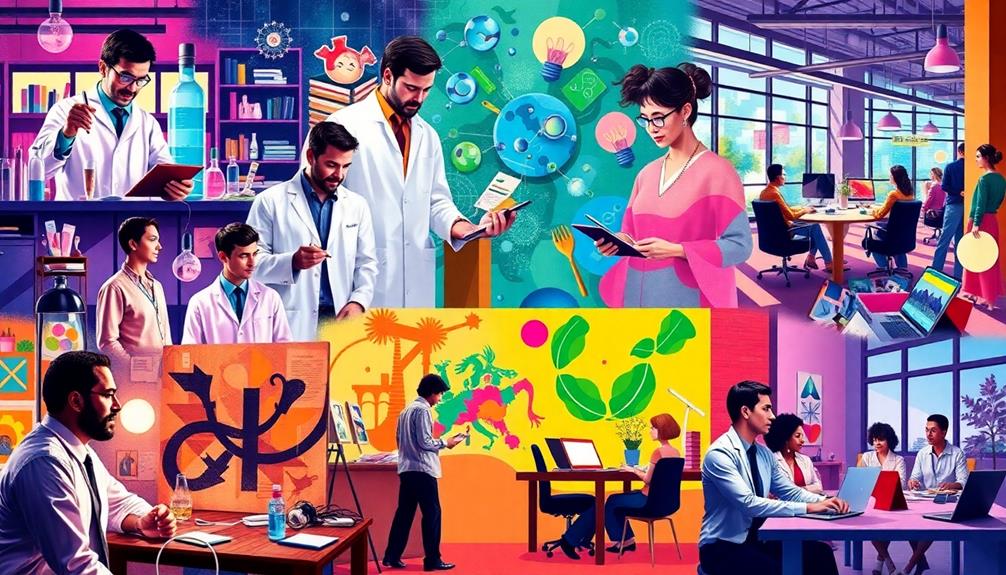Embracing lifelong learning enriches your life and sparks curiosity, driving personal and professional growth. This curious approach enhances critical thinking and adaptability, making complex challenges easier to tackle. You'll gain new skills, boost your confidence, and increase your overall job satisfaction. A curious mindset doesn't just expand your knowledge but also broadens your worldviews and improves relationships. Plus, lifelong learners often enjoy a boost in career advancement opportunities. By remaining open to new experiences and perspectives, you lay the groundwork for enduring success. Keep exploring, and you'll uncover even more powerful benefits waiting just around the corner.
Key Takeaways
- Curiosity enhances critical thinking, fostering deeper engagement and personal growth through exploration and inquiry-based learning.
- Lifelong learners enjoy increased career advancement opportunities, with a 30% higher likelihood of promotions due to continuous skill updates.
- Engaging in diverse perspectives boosts empathy and innovation, leading to improved relationships and creative problem-solving abilities.
- Continuous learning promotes cognitive health, sharpening attention and memory while enhancing self-esteem through the mastery of new skills.
- A curious mindset nurtures emotional well-being, providing a sense of purpose and fulfillment through lifelong learning experiences.
The Role of Curiosity in Learning

Curiosity fuels your learning journey, sparking deeper engagement and motivation. When you embrace curiosity, you naturally enhance your critical thinking skills.
You're more likely to explore diverse topics, asking questions that lead to richer understanding and personal development. This inquiry-based learning approach not only satisfies your thirst for knowledge but also fosters adaptability as you navigate new challenges.
Engaging in top wellness tips can further support your learning by promoting overall health and well-being. Research shows that curiosity boosts dopamine levels, making the learning process pleasurable and rewarding.
As a lifelong learner, you develop a love for exploration that encourages you to engage with the world in an open-minded way. This mindset is essential, as it allows you to tackle complex problems and seek innovative solutions.
Advantages of Lifelong Learning

Lifelong learning opens up multiple personal growth opportunities, helping you stay relevant in a fast-paced world.
By continuously updating your skills, you not only enhance your career prospects but also boost your confidence along the way.
Adopting a positive mindset, similar to Abraham's Business Success Principles, can further amplify the benefits of your learning journey.
Embracing this mindset leads to a more fulfilling and enriched life.
Personal Growth Opportunities
Often, engaging in lifelong learning can lead to significant personal growth opportunities. As you embrace the journey of continuous education, you'll discover how it catalyzes your development in various ways:
- Enhanced Self-Awareness: Learning about new topics helps you reflect on your beliefs and values, fostering deeper self-understanding. Additionally, as you explore diverse subjects, you may gain insights into your financial health, particularly in understanding the importance of monitoring credit card statements to catch fraud and manage expenses effectively credit card insights.
- Improved Cognitive Health: Keeping your brain active through diverse learning stimulates memory and decision-making, sharpening your problem-solving skills.
- Boosted Self-Esteem: Achieving new skills and knowledge can lift your confidence, making you feel capable and empowered as a lifelong learner.
- Broadened Worldview: Engaging with different cultures and perspectives enhances your empathy, enriching your interactions and relationships.
These personal growth opportunities not only contribute to your self-esteem but also equip you to tackle new challenges in life. The more you learn, the more adaptable and resilient you become.
Lifelong learning isn't just about acquiring knowledge; it's about nurturing the skills and mindset that empower you to thrive personally and socially. Embrace the adventure of lifelong learning, and watch yourself grow in ways you never imagined!
Career Advancement Insights
Investing in continuous learning can greatly boost your career advancement prospects. By engaging in lifelong learning, you stay updated with industry trends and acquire new skills that make you more competitive in the job market. Research shows that professionals who actively seek to upskill can see a 10-20% increase in salary.
Additionally, participating in workshops or earning certifications opens up valuable networking opportunities. These connections often lead to job referrals and collaborations, enhancing your chances for professional growth. In fact, employees who prioritize ongoing education are 30% more likely to receive promotions compared to those who don't.
Moreover, lifelong learners exhibit higher adaptability and problem-solving skills, both essential for maneuvering the complexities of modern workplaces. This adaptability not only helps you tackle challenges effectively but also positions you as a valuable asset to any organization.
Embracing continuous learning isn't just about keeping your résumé updated; it's about fostering a mindset that thrives on change and innovation.
Cultivating a Curious Mindset

To cultivate a curious mindset, you need to embrace new experiences and challenge your usual ways of thinking.
Start asking thought-provoking questions that push you to explore diverse perspectives.
This approach not only enriches your learning but also broadens your understanding of the world around you.
Embracing New Experiences
Embracing new experiences can open doors to a world brimming with curiosity and excitement. Each new adventure you take boosts your dopamine levels, enhancing your pleasure and creating a positive learning environment. By stepping outside your comfort zone, you not only foster personal growth but also build resilience.
Consider these benefits of embracing new experiences:
- Broadening Perspectives: Engaging in unfamiliar activities allows you to explore diverse topics, promoting innovative thinking.
- Enhancing Critical Thinking: Tackling new challenges sharpens your problem-solving skills, essential for maneuvering today's rapidly changing world.
- Boosting Emotional Well-Being: Research shows that individuals who regularly seek novel experiences report higher life satisfaction and emotional health.
- Cultivating Curiosity: Each new experience feeds your innate curiosity, making you more open-minded and enthusiastic to learn.
Ultimately, by actively seeking out and participating in new experiences, you enrich your life and lay the groundwork for a fulfilling, lifelong learning journey.
Asking Thought-Provoking Questions
Building on the excitement of new experiences, asking thought-provoking questions can greatly enrich your learning journey. When you embrace curiosity, you stimulate deeper thinking and engagement, which enhances retention and makes learning more meaningful. Inquiry-based learning emphasizes this approach, encouraging critical thinking and problem-solving skills essential for lifelong learning.
Here's a simple table showcasing the benefits of asking questions:
| Benefit | Description |
|---|---|
| Stimulates Engagement | Encourages deeper involvement in the learning process. |
| Enhances Retention | Promotes better memory of information acquired. |
| Fosters Open-Mindedness | Allows exploration of diverse perspectives. |
| Encourages Personal Growth | Leads to self-discovery and continuous development. |
| Boosts Motivation | Increases dopamine levels, making learning enjoyable. |
Exploring Diverse Perspectives
Curiosity fuels the journey of exploring diverse perspectives, transforming your understanding of the world. When you embrace this curious mindset, you reveal numerous benefits that enhance your lifelong learning experience.
Here's how engaging with different viewpoints can lead to personal growth:
- Critical Thinking: Analyzing diverse perspectives sharpens your ability to evaluate information and think critically.
- Empathy: Exposure to various cultures fosters empathy, allowing you to understand and appreciate others' experiences and challenges.
- Innovation: Varied inputs stimulate creative problem-solving, making you more innovative in your approach to challenges.
- Communication Skills: Engaging with a range of viewpoints teaches you to articulate your thoughts clearly and adapt your messaging for different audiences.
Strategies for Continuous Learning

Continuous learning is like nurturing a garden; it requires regular attention and effort to flourish. To cultivate your growth, start by embracing curiosity. Ask questions about the world around you; this habit leads to deeper understanding and engagement in new experiences.
Leverage technology to your advantage by enrolling in online courses, which offer diverse opportunities tailored to your interests and preferences. Regular reading across various genres not only broadens your perspectives but also enhances your critical thinking skills—an essential tool for adapting to change.
Set specific learning goals to maintain motivation, and regularly reflect on your progress to guarantee continuous self-improvement. Engaging in community learning is another powerful strategy. Share your knowledge and experiences with others; this fosters collaboration and networking, paving the way for personal growth and professional advancement.
By creating a supportive learning environment, you'll find inspiration and encouragement from those around you. Incorporating these strategies into your life can transform your approach to learning, making it an exciting and fulfilling journey.
Overcoming Learning Barriers

Learning barriers can feel like insurmountable walls, but with the right strategies, you can break through them.
First, start by overcoming misconceptions about learning; remember, education isn't just confined to classrooms. Embrace self-directed education to expand your horizons.
Next, focus on combatting the fear of failure. Reframe mistakes as learning opportunities. When you see challenges this way, you're more likely to engage fully in new experiences.
Third, adopt a growth mindset. This mindset emphasizes effort and resilience, viewing challenges as essential components of your learning journey. Each obstacle can be a stepping stone towards greater knowledge.
The Impact on Career Growth

Lifelong learning's benefits extend far beyond personal growth; it greatly impacts your career trajectory. By continuously engaging in learning experiences, you stay current with industry trends, which is essential in today's rapidly evolving job markets. This commitment to professional growth can lead to significant career advancement. In fact, studies show that individuals who actively pursue lifelong learning enjoy a 15% increase in their career advancement opportunities.
Participating in workshops and industry conferences not only enhances your knowledge and skills, but it also boosts your chances of promotion by 50% compared to those who don't engage in learning. Furthermore, the networking opportunities that arise from these experiences can connect you with potential job prospects and collaborations, further enhancing your career path.
Additionally, professionals who prioritize lifelong learning report a 20% increase in job satisfaction, directly linked to higher productivity and improved workplace performance. By investing in your education and expanding your skill set, you position yourself as a valuable asset to employers, ensuring that your career continues to flourish in an ever-changing landscape.
Embrace lifelong learning, and watch your career growth soar.
Nurturing Mental Well-Being

Investing in your mental well-being can be as simple as picking up a new skill or exploring a topic of interest. Engaging in lifelong learning not only stimulates cognitive functions but also enhances your emotional health.
Here are four ways it nurtures your mental well-being:
- Improved Cognitive Functions: Learning something new sharpens your attention, memory, and problem-solving skills, essential for maintaining good mental health.
- Enhanced Self-Confidence: Mastering new skills boosts your self-esteem, making you more resilient in the face of challenges.
- Sense of Purpose: Continuous learning fosters personal growth, providing fulfillment and a sense of direction in life.
- Social Connections: Participating in learning activities helps you build strong relationships with others who share your interests, enriching your emotional health.
Frequently Asked Questions
What Are the Benefits of Being a Curious Learner?
Being a curious learner opens up a world of possibilities for you.
You'll find that engaging deeply with new material enhances your retention and problem-solving skills. Curiosity boosts your motivation, making learning feel rewarding.
As you explore, you'll develop critical thinking abilities, allowing you to adapt to changes effectively. Plus, the joy of discovering new things contributes to your emotional well-being and life satisfaction, fostering resilience and a growth mindset along the way.
Why Is Curiosity Important for Lifelong Learning?
Curiosity's the secret sauce that can transform you from a passive observer into a knowledge-hungry superhero!
It fuels your passion for lifelong learning, making every moment an adventure. When you stay curious, you're constantly exploring new ideas, which sharpens your critical thinking and problem-solving skills.
Plus, curiosity helps you adapt to change like a chameleon, thriving in any environment.
What Are the Benefits of Curiosity Approach?
Curiosity opens doors to new experiences and knowledge, making your learning journey exciting and engaging.
When you actively explore your interests, you're more likely to retain information and develop critical thinking skills. These skills help you tackle challenges in both personal and professional areas.
Plus, embracing curiosity fosters adaptability, equipping you to thrive in a rapidly changing world.
Ultimately, curiosity not only enriches your life but also drives your personal growth and success.
What Are the Benefits of Being a Lifelong Learner?
Did you know that people who engage in lifelong learning are 50% more likely to report higher job satisfaction?
By embracing lifelong learning, you enhance your cognitive abilities, boost your confidence, and adapt to changes in your career. You not only expand your skill set but also enrich your personal life, exploring new interests and building valuable connections.
Ultimately, you create a more fulfilling and dynamic life, both personally and professionally.
Conclusion
In embracing lifelong learning, you open doors to endless possibilities. Curiosity fuels your journey, transforming challenges into opportunities. As you cultivate a curious mindset, you'll not only enhance your skills but also nurture your mental well-being. Remember, every new piece of knowledge is a step toward personal and professional growth. So, keep asking questions, explore new avenues, and let your thirst for understanding guide you. After all, the world's a classroom, and you're the enthusiastic student.









